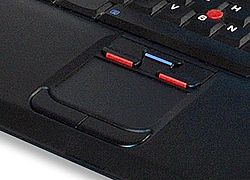Touchpad

A touchpad is an input device commonly used in laptop computers. They are used to move the cursor, using motions of the user's finger. They are a substitute for a computer mouse. Touchpads vary in size but are rarely made larger than 50 cm² (about 8 in²)
Touchpads commonly operate by sensing the capacitance of a finger, or the capacitance between sensors. Capacitive sensors are laid out along the horizontal and vertical axis of the touchpad. The location of the finger is determined from the pattern of capacitance from these sensors. This is why they will not sense the tip of a pencil or even a finger in a glove. Moist and/or sweaty fingers can be problematic for those touchpads that rely on measuring the capacitance between the sensors.
Touchpads are relative motion devices. That is, there is no isomorphism from the screen to the touchpad. Instead, relative motion of the user's fingers causes relative motion of the cursor. The buttons below or above the pad serve as standard mouse buttons. Depending on the model of touchpad and drivers behind it, you may also click by tapping your finger on the touchpad, and drag with a tap following by a continuous pointing motion (a click-and-a-half).
Some touchpads also have "hotspots": locations on the touchpad that indicate user intentions other than pointing. For example, on certain touchpads, moving your finger along the right edge of the touch pad will control the scrollbar and scroll the window that has the focus vertically. Moving the finger on the bottom of the touchpad often scrolls in horizontal direction.
Some touchpads can emulate multiple mouse buttons by either tapping in a special corner of the pad, or by tapping with two or more fingers.
Touchpads are primarily used in portable laptop computers, because the usual mouse device requires a flat table adjacent to the keyboard not always available away from the office. But touchpads have some advantages over the mouse, particularly that the pad's position is fixed relative to the keyboard, and very short finger movements are required to move the cursor across the display screen. Some computer users prefer them for such reasons, and desktop keyboards with built-in touchpads are available from specialist manufacturers.
Touchpads have also recently appeared in Apple's iPod. The main control interface for menu navigation in all of the currently produced iPods (except the Shuffle) is a touchpad (at first by Synaptics; Apple now manufactures that component themselves). Creative Labs also uses a touchpad in their Nomad Jukebox Zen line with the Zen Touch and Zen Micro.
The "trackpad" is Apple Computer's name for the touchpad. It was introduced in 1994 in the PowerBook 500 series, and replaced the trackball of previous PowerBook models. Latest Powerbook and iBook trackpads allow two finger usage for scrolling.
